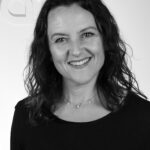Accuracy in reporting captures is a key element to achieve fisheries sustainability. However, identification of the catches might be a challenge when two or more species are morphologically similar and caught jointly, like the mixed fisheries of black hakes in East Atlantic African waters. Black hakes (Merluccius senegalensis and M. puddle) are tough to differentiate without previous training due to their high morphological resemblance. The two species are managed as a single stock, although the biological differences between them suggest the need for a separate management. In this study, a total of 806 black hakes were visually identified by fishermen on deck of fishing vessels operating in Mauritania and Senegal waters, then assigned to a species by sequencing 450bp of the Mitochondrial Control Region. Comparing the results with visual identification we found 31.4% of the total catch were incorrectly labeled on board by the fishermen. The accuracy of the fishermen's identification depended on the depth of capture and on fish size, larger individuals caught from deeper waters being more correctly assigned to M. puddle. Mislabelling biased to M. puddle suggests that M. senegalensis, already cataloged as endangered, is being underreported, which could endanger the conservation of this species and threaten the sustainability of black hake fisheries. Our results highlight the need for separate evaluation of the stocks in mixed fisheries for morphologically similar fish. Thus, monitoring through DNA barcoding in the very first step of the seafood chain surveys would improve accurate species delimitation and reduce its impact on the correct assessment of the stocks.
Category: Branches
Background/objectives: Malnutrition is common among older adults. Dietary intervention studies in older adults aiming to improve anthropometric measures and physical function have been inconsistent. We aimed to investigate the effects of nutrition therapy in combination with home delivered meals and oral nutritional supplements (ONS) in community-dwelling older adults discharged from hospital.
Methods: A total of 106 participants (>65 years) were randomized into the intervention group (n = 53) and into the control group (n = 53). The intervention group received individual nutrition therapy (five in person visits and three phone calls) and freely delivered energy- and protein-rich foods, while the control group received standard care. Dietary intake, anthropometrics, and short physical performance battery (SPPB) were assessed at baseline and at endpoint.
Results: Energy intake at baseline was similar in both groups (~1500 kcal at the hospital) but there was a significant increase in energy intake and body weight in the intervention group (+919 kcal/day and 1.7 kg, P < 0.001 in both cases) during the study period, compared to a significant decrease in both measures among controls (-815 kcal/day and -3.5 kg, P < 0.001 in both cases). SPPB score increased significantly in the intervention group while no changes were observed among controls.
Conclusions: Most Icelandic older adults experience substantial weight loss after hospital discharge when receiving current standard care. However, a 6-month multi-component nutrition therapy, provided by a clinical nutritionist in combination with freely delivered supplemental energy- and protein-dense foods has beneficial effects on body weight, physical function, and nutritional status.
Study registration: This study was registered at ClinicalTrials.gov ( NCT03995303 ).
The island of Surtsey was formed in 1963–1967 on the offshore Icelandic volcanic rift zone. It offers a unique opportunity to study the subsurface biosphere in newly formed oceanic crust and an associated hydrothermal-seawater system, whose maximum temperature is currently above 120 ° C at about 100m below surface. Here, we present new insights into the diversity, distribution, and abundance of microorganisms in the subsurface of the island, 50years after its creation. Samples, including basaltic tuff drill cores and associated fluids acquired at successive depths as well as surface fumes from fumaroles, were collected during expedition 5059 of the International Continental Scientific Drilling Program specifically designed to collect microbiological samples. Results of this microbial survey are investigated with 16S rRNA gene amplicon sequencing and scanning electron microscopy. To distinguish endemic microbial taxa of subsurface rocks from potential contaminants present in the drilling fluid, we use both methodological and computational strategies. Our 16S rRNA gene analysis results expose diverse and distinct microbial communities in the drill cores and the borehole fluid samples, which harbor thermophiles in high abundance. Whereas some taxonomic lineages detected across these habitats remain uncharacterized (eg, Acetothermiia, Ammonifexales), our results highlight potential residents of the subsurface that could be identified at lower taxonomic rank such as Thermaerobacter, BRH-c8a (Desulfallas-Sporotomaculum), Thioalkalimicrobium, and Sulfurospirillum. Microscopy images reveal possible biotic structures attached to the basaltic substrate. Finally, microbial colonization of the newly formed basaltic crust and the metabolic potential are discussed on the basis of the data.
Novel thermophilic heterotrophic bacteria were isolated from the subsurface of the volcanic island Surtsey off the south coast of Iceland. The strains were isolated from tephra core and borehole fluid samples collected below 70 m depth. The Gram-negative bacteria were rod-shaped (0.3-0.4 µm wide, 1.5-7 µm long), aerobic, non-sporulating and non-motile. Optimal growth was observed at 70 °C, at pH 7-7.5 and with 1% NaCl. Phylogenetic analysis identified the strains as members of the genus Rhodothermus. The type strain, ISCAR-7401T, was genetically distinct from its closest relatives Rhodothermus marinus DSM 4252T and Rhodothermus profundi PRI 2902T based on 16S rRNA gene sequence similarity (95.81 and 96.01%, respectively), genomic average nucleotide identity (73.73 and 72.61%, respectively) and digital DNA-DNA hybridization (17.6 and 16.9%, respectively). The major fatty acids of ISCAR-7401T were iso-C17:0, anteiso-C15:0, anteiso-C17:0 and iso-C15:0 (> 10 %). The major isoprenoid quinone was MK-7 while phosphatidylethanolamine, diphosphatidylglycerol, an unidentified aminophospholipid and a phospholipid were the predominant polar lipid components. Based on comparative chemotaxonomic, genomic and phylogenetic analyzes, we propose that the isolated strain represents a novel species of the genus Rhodothermus with the name Rhodothermus bifroesti sp. nov. The type strain is ISCAR-7401T(= DSM 112103T= CIP 111906T).
This paper summarizes the lessons learned from the implementation of a practical approach to Results-based Management (RBM) within the EU H2020 FarFish project, where RBM is conceptualized as a contract situation. From these lessons a set of policy recommendations for the improvement of the fisheries management through the adoption of RBM for EU vessels fishing in international- and Sustainable FisheriesPartnership Agreements (SFPA) waters were put forward. The policy recommendations are based on key project outputs and additional semi-structured interviews on the experiences of project partners. This exercise revealed advancements and shortcomings for the broader implementation of a more participatory, inclusive, and responsive approach to fisheries governance. Meaningful and effective participation was a pivotal factor for the success of the process. Absence of relevant bodies, sectors and fleet segments proved detrimental throughout all cases. The importance of scoping, goal setting and timing of the actions, as well as managing realistic expectations within the RBM, were highlighted. Data availability and accountability was pivotal, as in cases where cooperation was successful, data was made available, and knowledge was expanded and enriched. The implementation of this approach to RBM showed great potential when extended to other aspects of fisheries' management, fishing categories and fleets. This structured approach to RBM provides a promising alternative to current fisheries management systems around the world.
This study describes the structure of DNA polymerase I from Thermus phage G20c, termed PolI_G20c. This is the first structure of a DNA polymerase originating from a group of related thermophilic bacteriophages infecting Thermus thermophilus, including phages G20c, TSP4, P74-26, P23-45 and phiFA and the novel phage Tth15-6. Sequence and structural analysis of PolI_G20c revealed a 3′–5′ exonuclease domain and a DNA polymerase domain, and activity screening confirmed that both domains were functional. No functional 5′–3′ exonuclease domain was present. Structural analysis also revealed a novel specific structural motif, here termed SβαR, that was not previously identified in any polymerase belonging to the DNA polymerases I (or the DNA polymerase A family). The SβαR motif did not show any homology to the sequences or structures of known DNA polymerases. The exception was the sequence conservation of the residues in this motif in putative DNA polymerases encoded in the genomes of a group of thermophilic phages related to Thermus phage G20c. The structure of PolI_G20c was determined with the aid of another structure that was determined in parallel and was used as a model for molecular replacement. This other structure was of a 3′–5′ exonuclease termed ExnV1. The cloned and expressed gene encoding ExnV1 was isolated from a thermophilic virus metagenome that was collected from several hot springs in Iceland. The structure of ExnV1, which contains the novel SβαR motif, was first determined to 2.19 Å resolution. With these data at hand, the structure of PolI_G20c was determined to 2.97 Å resolution. The structures of PolI_G20c and ExnV1 are most similar to those of the Klenow fragment of DNA polymerase I (PDB entry 2 kzz) from Escherichia coli, DNA polymerase I from Geobacillus stearothermophilus (PDB entry 1 knc) and Taq polymerase (PDB entry 1 bgx) from Thermus aquaticus.
This study describes the production, characterization and structure determination of a novel Holliday junction-resolving enzyme. The enzyme, termed Hjc_15-6, is encoded in the genome of phage Tth15-6, which infects Thermus thermophilus. Hjc_15-6 was heterologously produced in Escherichia coli and high yields of soluble and biologically active recombinant enzyme were obtained in both complex and defined media. Amino-acid sequence and structure comparison suggested that the enzyme belongs to a group of enzymes classified as archaeal Holliday junction-resolving enzymes, which are typically divalent metal ion-binding dimers that are able to cleave X-shaped dsDNA-Holliday junctions (Hjs) . The crystal structure of Hjc_15-6 was determined to 2.5 Å resolution using the selenomethionine single-wavelength anomalous dispersion method. To our knowledge, this is the first crystal structure of an Hj-resolving enzyme originating from a bacteriophage that can be classified as an archaeal type of Hj-resolving enzyme. As such, it represents a new fold for Hj-resolving enzymes from phages. Characterization of the structure of Hjc_15-6 suggests that it may form a dimer, or even a homodimer of dimers, and activity studies show endonuclease activity towards Hjs. Furthermore, based on sequence analysis it is proposed that Hjc_15-6 has a three-part catalytic motif corresponding to E-SD-EVK, and this motif may be common among other Hj-resolving enzymes originating from thermophilic bacteriophages.
News about climate change hits us every day, so it's clear that it's time to take action. But what is the best way to teach children and young people about such difficult issues so that they are encouraged to take action? It will be them and their descendants who will be affected by climate change, and it is therefore important that they receive education and increased knowledge of what may lie ahead. The need for quality education on the issue, which also does not promote climate anxiety, is becoming more and more inevitable. The answer may lie in innovation. These students will take over the board one day, so it is important that students receive quality education about innovation and entrepreneurship from a young age. Objectives Green Entrepreneurs of the Future (GFF) was tackling this challenge by giving students in rural areas the opportunity for innovative education and getting them interested in climate and environmental issues. Matís is responsible for the project and it took place in three elementary schools in the countryside. A number of participants came to the project, including FabLab workshops and fishing companies in the local area, N4 TV station and others. The project was financed by the Climate Fund and was originally planned for one year.
External conditions can drive biological rates in ectotherms by directly influencing body temperatures. While estimating the temperature dependence of performance traits such as growth and development rate is feasible under controlled laboratory settings, predictions in nature are difficult. One major challenge lies in translating performance under constant conditions to fluctuating environments. Using the butterfly Pieris napi as a model system, we show that development rate, an important fitness trait, can be accurately predicted in the field using models parameterized under constant laboratory temperatures. Additionally, using a factorial design, we show that accurate predictions can be made across microhabitats but critically hinge on adequate consideration of non-linearity in reaction norms, spatial heterogeneity in microclimate and temporal variation in temperature. Our empirical results are also supported by a comparison of published and simulated data. Conclusively, our combined results suggest that, discounting direct effects of temperature, insect development rates are generally unaffected by thermal fluctuations.
Seasons impose different selection pressures on organisms through contrasting environmental conditions. How such seasonal evolutionary conflict is resolved in organisms whose lives span across seasons remains underexplored. Through field experiments, laboratory work, and citizen science data analyses, we investigate this question using two closely related butterflies (Pieris rapae and P. napi). Superficially, the two butterflies appear highly ecologically similar. Yet, the citizen science data reveal that their fitness is partitioned differently across seasons. Pieris rapae have higher population growth during the summer season but lower overwintering success than do P. napi. We show that these differences correspond to the physiology and behavior of the butterflies. Pieris rapae outperform P. napi at high temperatures in several growth season traits, reflected in microclimate choice by ovipositing wild females. Instead, P. rapae have higher winter mortality than do P. napi. We conclude that the difference in population dynamics between the two butterflies is driven by seasonal specialization, manifested as strategies that maximize gains during growth seasons and minimize harm during adverse seasons, respectively.





